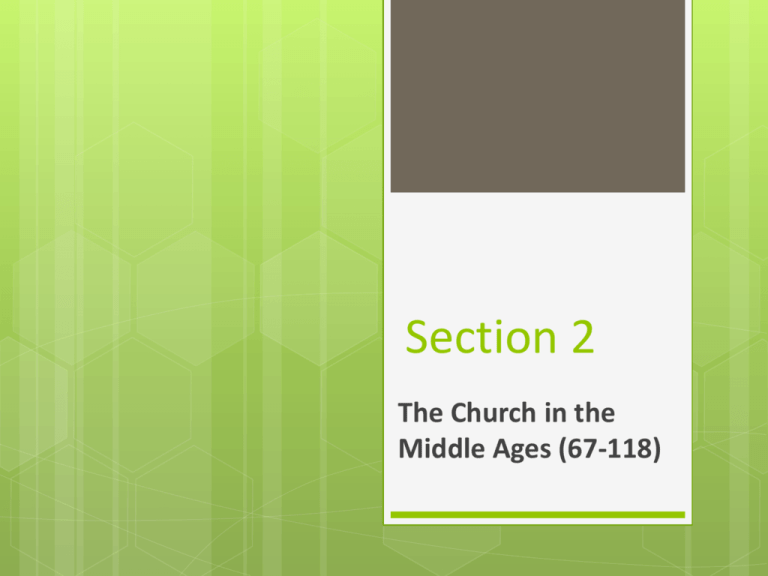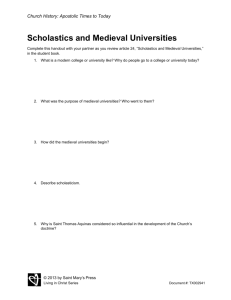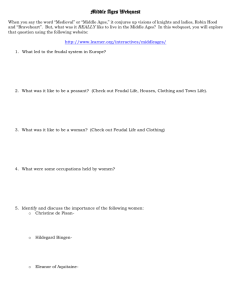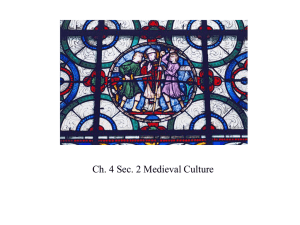Sec 2 * Part 1 - WordPress.com
advertisement

Section 2 The Church in the Middle Ages (67-118) Section 2, Part 3 The High (and Late) Middle Ages (pp. 98-118) Introduction High Middle Ages (1000-1350) and Late Middle Ages (1350-1500) Monastic reform and form Building advances led to architectural advances of Gothic Cathedrals Universities and scholasticism grew in towns around cathedrals Period of intense religious and secular European society Catalyzed by ancient Greek works brought to west by crusaders Eucharistic theology and devotion emerged as defended from heresy Inquisitions one defended teachings of Lateran IV; one national Five Articles (A. 22) – New Religious Orders (pp. 99-103) (A. 23) – Medieval Cathedrals: Works of Beauty and Inspiration (pp. 103106) (A. 24) – Scholastics and Medieval Universities (pp. 106-109) (A. 25) – The Eucharist: Heresies, Teachings, and Devotions (pp. 110-113) (A. 26) – Understanding the Inquisitions (pp. 113-117) Article 22: New Religious Orders (pp. 99-103) Developments in Religious Life during the High Middle Ages Renewal of Benedictine monasticism Roots in 909 with monastery in Cluny, France Carthusians (Bruno) and Cistercians (Bernard) were founded in 11th century Adaptations of St. Benedict’s Rule—austere hermits and poor solitary monks who labor (advances) New Religious Orders--Mendicants (beggars = hand to mouth) Renewal outside the monastery walls; active lifestyle with apostolate; mobile; begging Franciscans—Order of Friars Minor (OFM)—St. Francis of Assisi (1180/81-1226) Biography of Francis Approval of first mendicant rule in 1209 by Innocent III Friars vs. monks Spirituality of poverty and imitation of Christ = renewal at the time Still alive today = Pope Francis and Prayer of St. Francis Dominicans—Order of Preachers (OP)—St. Dominic de Guzman (1170-1221) Return to rule and spirit of St. Benedict, true discipleship, poverty and simplicity, freedom from lay Spread throughout Europe by 1050 Educated traveling friars to teach and preach against heresy, esp. Albigensianism Approved in 1215 by Innocent III and spread in western and central Europe Communal houses near universities (Paris, Bologna, … ) St. Thomas Aquinas—most famous Black Friar Female Religious Orders—founder of Poor Clares = first mendicant order/rule for women; previously Scholatines—monastic order for women Homework For Thursday: Read pp. 103-109 (AA. 23-24) in the e-Book for discussion in class Thursday P. 118; 1-3 Article 23: Medieval Cathedrals: Works of Beauty and Inspiration (pp. 103-106) Church architectural changes: house; simple stone; basilicas in 313; regional variances but unchanged until 1000; cathedrals Each major town had its own cathedral—center of life (Christian) No expense was spared—large, grand, precious, intricate Reciprocal relationship of cathedral to population growth (skilled) Workers were master artisans and engineers Multi-generational project—size, time, money = centrality of faith Gothic vs. Romanesque type (R): hugh pillars, rounded arches, stone roofs, thick fortress walls, small windows but lots of light, cherubs, clouds, light colors, gold leaf (G): high thin walls, ribbed-vault ceilings, tall spires, flying buttresses, airy, graceful, stained glass (rose on west nave wall; catechesis), gargoyles Interior aspects: chancel (choir) for the Divine Office, high altar, cathedra, side chapels for private masses vs. people’s mass, relics of saints and kings, pulpit for long catechetical sermons, also apse, transepts, and side aisles (2 or 4) Medieval cathedral vs. modern day one Article 24: Scholastics and Medieval Universities (pp. 106-109) Colleges & universities you are pondering have their roots the H.M.A. First schools attached to monasteries in 6th century Classes were taught by educated monks and nuns to seminarians (tonsure) and a primary form of catechesis for laity As cathedrals developed in the 11th and 12th centuries, schools developed into universities as teachers and students gathered Universitas model (guild) for mutual protection: licenses & degrees Study liberal arts (astronomy, music, grammar, rhetoric, logic, math, geometry) and sciences (theology, law, medicine) Males at 14: 6 years for a bachelors & 12 more for a master/doctorate South: law & medicine (Bologna 1088, Salamanca 1218, Padua 1222, Coimbra 1290, ) North: liberal arts, canon law, & theology—”queen of the sciences” (Paris 1150, Oxford 1167, Cambridge 1209, Prague 1348, Cracow 1364 80 by 1300; more by 1400; most still open today Article 24 cont.: Scholastics and Medieval Universities (pp. 106-109) Scholasticism 1100-1500 in medieval universities Dialectical method of thinking, teaching, and writing through reasoned arguments between two or more parties Object—all scientific knowledge but especially knowledge of God First principle—faith and reason can be reconciled Primary objective—reconcile ancient Greek thought (esp. Aristotle) with traditional Christian thought Key Figures Anselm of Canterbury (1033-1109)—Benedictine: theology = faith seeking understanding; inquire into truths of scripture Peter Abelard (1079-1142)—lay: theological method; question (quaestio), investigate (interrogatio), argument, and final resolution (disputatio) Thomas Aquinas (1225-1274)—Dominican; jewel of Scholasticism John Duns Scotus (1265-1308)—Franciscan: Scripture; Immaculate Conc. Homework Read pp. 110-117 (AA. 25-26) in the eBook for class discussion Tuesday P. 118; 5-7 Article 25: The Eucharist: Heresies, Teachings, & Devotions (pp. 110-113) Heresy of Albigensianism rose in France in the 12th century Medieval version of gnosticism—dualistic; matter is bad Concluded Sacraments and priests are bad, esp. the Eucharist Bernardo Gui, OP (1262-1331) quote Church responded with the IV Lateran Council (1215) Called by Innocent III (1198-1216) 1200 bishops passed 70 canons Celibacy, simony, seal of confession, annual confession and Easter duty, 7 Sacraments, etc… Transubstantiation St. John Chrysostom—words are priest, power is Christ Council of Trent (1545-1563)—further clarified Point of distinction between Catholics and Protestants Article 25 cont.: The Eucharist: Heresies, Teachings, & Devotions (pp. 110-113) St. John Paul II—Eucharist is the life of the Church Medieval Eucharistic Devotions emerge Feast of Corpus Christi Eucharistic Adoration Thursday or Sunday after Trinity Sunday (Thurs. or Sun. after Trinity Sun.) Juliana of Liege, Belgium—synod in 1246 Urban IV (1261-1264)—papal bull made universal Exposed in monstrance or ciborium St. Franics—religious and priests in Italy King Louis VIII (1187-1226)—lay; began as thanksgiving for victory over Albi. St. Clare of Assisi (1194-1253) Depicted in religious art with a monstrance Thomas Celano relates story of Saracen conquest in 1240 Article 26: Understanding the Inquisitions (pp. 113-117) Inquisition—inquire or unfair trial? Two events (times, purposes, and conduct)—simplifying danger U.S.A.—Red Scare and Exploration of America Medieval (Papal/Roman) Inquisition (conversion stamps out heresy) Practice dates back to Constantine in the 4th century Civil practice of capture and punishment (fines, prison, corporal; death) Tradition of objection—Ambrose of Milan focused on conversion Practice dies out with the Roman Empire’s fall to barbarians Albigensians & Waldensians in 12th prompted re-emergence in 13th Pope Gregory IX in 1231--Rome & focused on Italy, France, and Germany Dominican and Franciscan inquisitors—educated, devoted, & free Tribunal (3)—power to investigate and judge; process Mistakes—secret, word as evidence, death, abuse of power, climate Misunderstandings—most penalties canonical, civil executed Article 26 cont.: Understanding the Inquisitions (pp. 113-117) Spanish Inquisition Under Spanish monarchy not Pope Sixtus IV Facts also over simplified and misunderstood Began in 15th century (1478-1834) Political motive of unifying Spain to bolster leadership First inquisitors and auto da fe in 1481 Pope Sixtus tried to control the inquisition process; Ferdinand rejected so he lost all control Targeted recent converts and sinners First 60 years—3,000 conversos executed Next 300 years—more trials than executions Shifted to Protestant focus and then purity of blood for ordinations in the New World Timeline on p. 117 Homework p. 118; 4, 8-9 Study for the 2.3 Quiz tomorrow (pp. 98118; AA. 22-26) Make sure the 2.3 HW is ready to turn in tomorrow (p. 118; 1-9)







